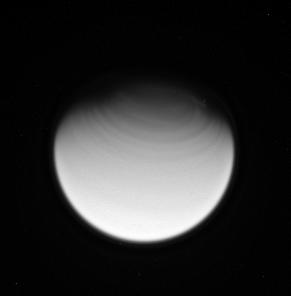IPSL Titan GCM
Early developments
The first model of Titan's atmospheric circulation was developed by Frederic Hourdin at LMD in early 1990's, based around a GCM dynamical core developed for the Earth's atmosphere, but adapted for Titan conditions for all model parameters and including full radiative transfer. This model was the first to successfully spin up the atmosphere of Titan from rest up to superrotation with zonal winds comparable to observed values. The vertical range of this GCM (referred to as the LMD model) was from the surface up to roughly 250 km. Radiative transfer was computed using a horizontally uniform vertical profile of haze and gases (inherited from the model developed by McKay et al., 1989) everywhere on the planet.
Two-dimensional Climate Model
During my PhD, I developed a two-dimensional photochemical model (Lebonnois et al., 2001), using an analytic approximation of the meridional transport based on the circulation modeled by Hourdin et al. (1995). This work demonstrated the role of the circulation in the latitudinal and seasonal variations of the stratospheric composition of gaseous compounds, but did not study changes in the haze distribution, nor was capable of studying feedbacks on the circulation produced by variations in composition.
In order to include coupling with haze within the LMD Titan GCM, Rannou et al. (2004) developed a 2-dimensional axi-symmetric (latitude-altitude) version of the dynamical model. This 2-dimensional climate model (2D-CM) developed at IPSL (Institute Pierre-Simon Laplace) covered altitudes from the surface to roughly 500 km. It used a specific parameterization to take into account the horizontal mixing by barotropic waves, that were obtained in the early GCM of Hourdin et al. (1995) but could not be present in the 2-dimensional reduction of the model. This parameterization used the diagnosed barotropic instabilities to evaluate the horizontal mixing coefficient associated with the corresponding waves (work done by David Luz during his PhD at LMD: Luz et al. (2003a,b)). Rannou et al. (2002,2004) demonstrated the strong interaction there is between haze distribution and dynamics, and used the model to interpret many features of the haze layer, in particular providing a possible explanation for the detached haze observed at 350 km altitude at the time of Voyager 1.
The IPSL 2D-CM was further developed to include the photochemical model of Lebonnois et al. (2001). The effects of the coupling between gaseous composition and dynamics were studied, and found to have a far weaker impact on the circulation than coupling between haze and dynamics (see Lebonnois et al. 2003b, Hourdin et al. 2004).
A comparison of the Cassini/CIRS results with the latest version of the IPSL 2D-CM was done during Audrey Crespin's PhD (Crespin et al., 2008). The model reproduced the thermal structure observed in the troposphere and stratosphere, the abundance and vertical profiles of most chemical compounds in the stratosphere, and their enrichment in the winter polar region. A reference simulation may be found here (Rannou et al., 2005), and a review of the interactions between haze, dynamics and composition may be found in Lebonnois et al. (2009). The most recent development of this 2-dimensional Climate Model is the introduction of tropospheric cloud microphysics, with a full description of the methane cycle in Titan's troposphere (Rannou et al., 2006).
The IPSL Titan Global Climate Model
A full GCM version of the IPSL Model was developed based on the LMDZ4 dynamical core (Lebonnois et al., 2012). This GCM included the coupling with haze that was developed for the 2-dimensional version of the model, though microphysical processes were computed in zonal average. Starting from the 2-dimensional results, superrotation is maintained in the 3-dimensional simulations. Boundary layer parameterization was improved, resulting in very realistic tropospheric zonal wind profiles. Gravitational tides from Saturn are now included.
Computation of the atmospheric composition was included, with the photochemical module computing both in the GCM domain (0-500 km) and above, using vertical 1-dimensional columns without horizontal transport (500-1300 km). As for the microphysics, photochemistry is computed only as a zonal (and diurnal) average.
A detailed analysis of the tropospheric circulation in the GCM was done during Benjamin Charnay's PhD. Among his many results, Benjamin Charnay was able to interpret the vertical profile of potential temperature calculated from in situ temperature and pressure data of the Huygens Atmospheric Structure Instrument (HASI), which revealed several structures: a weakly convective planetary boundary layer (PBL) of 300 m depth, another weak shoulder around 800 m, and a change of vertical lapse rate near 2 km. With the IPSL Titan GCM, Charnay and Lebonnois (2012) demonstrated that the weak feature at 800 m is the residual signature of the maximum diurnal extension of the convective boundary layer, while the feature at 300 m corresponds to the location of this layer at the local time of the Huygens' probe descent (at around 10AM). We also showed that the change of lapse rate around 2 km corresponds to the vertical extent of the strongest vertical mixing by the ascending branch of the deepest Hadley circulation (the ITCZ). In the IPSL Titan GCM's simulations, this region moves from high latitudes in the summer hemisphere to the other hemisphere around equinox, and induces this change in the temperature lapse rate all year long, its signature disappearing only for winter high-latitudes, when surface temperatures reach minimum values. These combined influences indicate that Titan's PBL is more dynamic than thought previously and may undergo both seasonal and diurnal variations. Sunlight warms up the surface and this heat is transferred to the PBL by near-surface turbulence in the form of sensible heat flux.
Currently, Jan Vatant d'Ollone is building a new version of the IPSL Titan GCM. During his PhD, he implemented a new radiative transfer scheme that improved a lot the temperature structure in the stratosphere. Jan is studying the seasonal variations of temperature and composition in the simulations, as observed by Cassini/CIRS. In this version of the GCM, the microphysical module is not yet operational and coupling with haze is not present.
